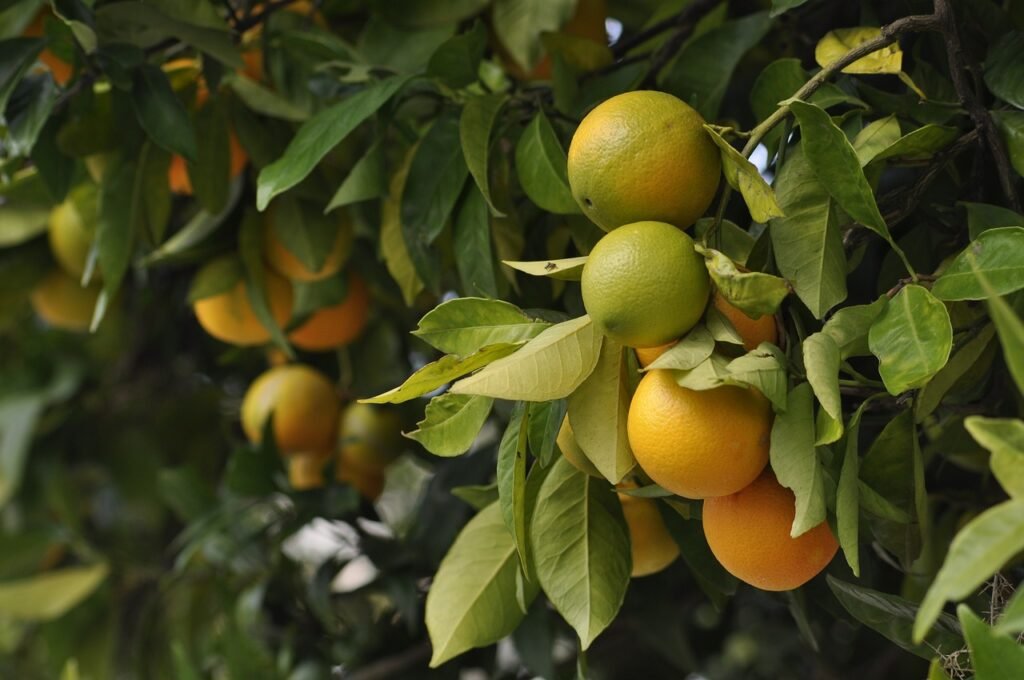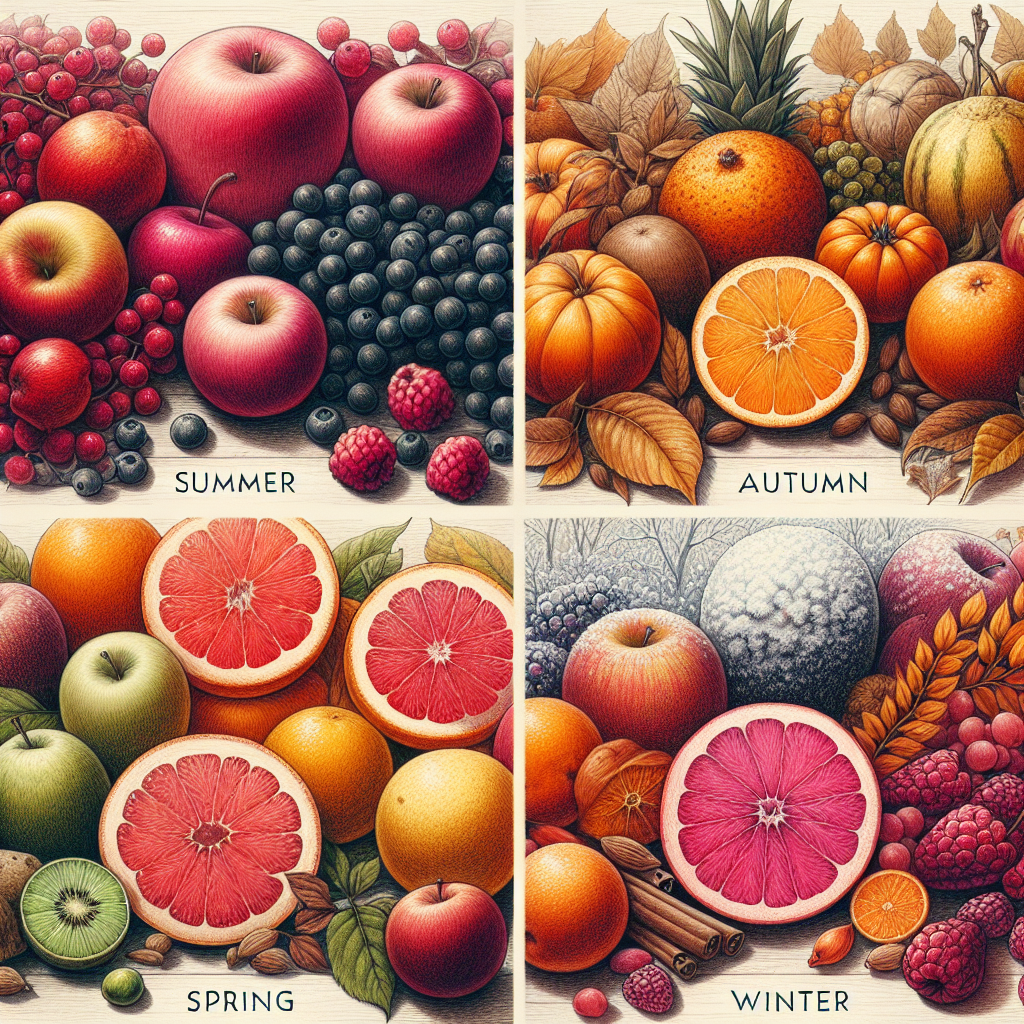Have you ever wondered which fruits are available throughout the year? In this article, we will take a delightful journey through the four seasons of fruits. From the vibrant berries of summer to the crisp apples of autumn, discover the unique flavors and nutritional benefits that each season has to offer. So, get ready to tantalize your taste buds and explore the bountiful world of fruits throughout the year!

Seasonal Fruits
Definition
Seasonal fruits refer to the fruits that are naturally harvested and available during a specific time of the year. These fruits are typically grown and harvested within their natural growing seasons, allowing them to fully develop in terms of flavor, texture, and nutritional content.
Importance of Eating Seasonal Fruits
Eating seasonal fruits not only supports local farmers and the economy but also provides numerous benefits to your health and overall well-being. Seasonal fruits are known to be fresher and tastier, as they are picked at the peak of their ripeness. They contain higher levels of vitamins, minerals, and antioxidants compared to fruits that are grown out of season and have to be transported long distances.
Benefits of Seasonal Fruits
There are several advantages to including seasonal fruits in your diet. Firstly, they offer a wider variety of flavors and textures throughout the year, making your meals more enjoyable. Additionally, seasonal fruits provide a greater range of nutrients, as different fruits offer different vitamins and minerals. By consuming a variety of seasonal fruits, you can ensure that your body receives a diverse array of essential nutrients. Furthermore, seasonal fruits are often more affordable and readily available, making them a cost-effective and convenient option for maintaining a healthy diet.
Spring Fruits
List of Spring Fruits
During the spring season, you can enjoy a delightful selection of fresh and vibrant fruits. Some popular spring fruits include strawberries, cherries, apricots, rhubarb, and pineapples. These fruits are bursting with flavor and nutrients, making them an excellent choice to incorporate into your springtime meals.
Nutritional Benefits
Spring fruits boast an array of health benefits. Strawberries, for example, are packed with vitamin C, which supports the immune system and promotes radiant skin. Cherries are rich in antioxidants that have been linked to reducing inflammation and improving sleep quality. Apricots are a good source of dietary fiber, aiding digestion and promoting satiety. Rhubarb is low in calories but high in fiber and vitamin K, which is essential for bone health. Lastly, pineapples contain bromelain, an enzyme known for its anti-inflammatory and digestive benefits.
Recipe Ideas
There are countless delicious ways to incorporate spring fruits into your meals. For a refreshing spring salad, combine fresh strawberries, mint leaves, arugula, and a sprinkle of feta cheese. Alternatively, you can make a mouthwatering cherry and almond tart or a delightful apricot and rhubarb crumble. Fresh pineapple can be added to smoothies or grilled and served alongside grilled chicken or fish for a tropical twist.

Summer Fruits
List of Summer Fruits
Summer is a season synonymous with an abundance of juicy and refreshing fruits. Some popular summer fruits include watermelon, peaches, plums, mangoes, and blueberries. These fruits are not only delicious but also provide a much-needed cooling effect during the hot summer months.
Nutritional Benefits
Summer fruits offer a wealth of health benefits to keep you energized and hydrated during the summer heat. Watermelon, for instance, has a high water content, helping to keep you hydrated. Peaches and plums are rich in vitamins A and C, promoting healthy skin and supporting immune function. Mangoes are a great source of fiber and contain antioxidants that help fight against free radicals. Lastly, blueberries are packed with antioxidants, contributing to brain health and reducing the risk of chronic diseases.
Recipe Ideas
Take advantage of the bountiful summer fruits by whipping up some mouthwatering recipes. Create a refreshing watermelon and feta salad by combining diced watermelon, crumbled feta cheese, fresh mint leaves, and a drizzle of balsamic glaze. Make a delicious peach and plum salsa to accompany grilled chicken or fish. Try blending mangoes into a tropical smoothie or making a blueberry and lemon zest tart for a delightful dessert.
Autumn Fruits
List of Autumn Fruits
As summer transitions into autumn, nature offers a new array of flavors and textures. Some popular autumn fruits include apples, pears, figs, pomegranates, and grapes. These fruits are known for their richness and versatility, making them perfect for both sweet and savory dishes.
Nutritional Benefits
Autumn fruits are not only delicious but also provide a range of health benefits to support your well-being. Apples and pears are high in dietary fiber, aiding digestion and promoting heart health. Figs are a good source of potassium, which helps maintain healthy blood pressure levels. Pomegranates are packed with antioxidants and have been associated with reducing inflammation and protecting against certain types of cancer. Grapes are rich in antioxidants called polyphenols, which have been linked to improved brain function and heart health.
Recipe Ideas
Autumn fruits can be incorporated into a variety of dishes, adding a delightful twist to your meals. Create a hearty apple and pear salad by combining sliced apples, pears, mixed greens, toasted walnuts, and a drizzle of honey mustard dressing. Make a flavorful fig and prosciutto flatbread by topping a pizza crust with figs, prosciutto, arugula, and goat cheese. Use pomegranate seeds to garnish roasted vegetables or prepare grape and cheese skewers as a healthy snack.

Winter Fruits
List of Winter Fruits
During the winter season, nature provides an array of fruits that are both nourishing and comforting. Some popular winter fruits include citrus fruits like oranges, grapefruits, and lemons, as well as kiwis, pears, and persimmons. These fruits are rich in vitamins and minerals, offering a bright burst of flavor during the colder months.
Nutritional Benefits
Winter fruits are packed with essential nutrients that support your immune system and overall health. Oranges, for example, are abundant in vitamin C, which helps fight off common colds and flu. Grapefruits are high in fiber and contain antioxidants that promote healthy skin and manage weight. Kiwis are a great source of vitamin K, which plays a crucial role in blood clotting and bone health. Pears are rich in dietary fiber, aiding digestion and promoting satiety. Finally, persimmons are loaded with vitamin A, which is essential for good vision and a strong immune system.
Recipe Ideas
Winter fruits can be enjoyed in a variety of comforting and nourishing recipes. Start your day with a vibrant citrus fruit salad, combining segments of orange, grapefruit, and lemon zest. Create a refreshing kiwi and spinach smoothie packed with vitamins and minerals. Make a delicious pear and goat cheese crostini by layering sliced pears, goat cheese, and a drizzle of honey on toasted bread. Indulge in a persimmon pudding for a warming and satisfying dessert.
Fruits Common to All Seasons
List of Fruits That Are Available All Year
While certain fruits are associated with specific seasons, there are a few fruits that are available throughout the year. Some common fruits available year-round include bananas, apples, grapes, strawberries, and citrus fruits. These fruits are widely cultivated and can be enjoyed in various dishes regardless of the season.
Nutritional Benefits
Fruits that are available year-round provide consistent nutritional benefits, ensuring a diverse intake of vitamins and minerals. Bananas are rich in potassium, which supports heart health and helps control blood pressure. Apples are packed with fiber and antioxidants, promoting digestive health and reducing the risk of chronic diseases. Grapes offer a range of antioxidants that benefit cardiovascular health and eye health. Strawberries are a good source of vitamin C, contributing to the immune system and collagen production. Citrus fruits, such as oranges and lemons, are abundant in vitamin C and other essential nutrients, supporting overall health and well-being.
Recipe Ideas
With the availability of these fruits throughout the year, the culinary possibilities are endless. Slice bananas and add them to your morning cereal or yogurt for a quick and nutritious breakfast. Create a classic apple pie or bake apples with a sprinkle of cinnamon for a comforting and aromatic dessert. Whip up a refreshing grape and strawberry salad with a drizzle of honey and a squeeze of lemon juice. Squeeze fresh citrus fruits to make homemade lemonade or create a zesty salad dressing.

Factors Affecting Fruit Availability
Geographical Region
The availability of fruits can vary depending on the geographical region. Fruits that are grown locally are more likely to be available during their respective seasons and may not be as accessible in regions with different climates. Different regions have different growing conditions and climate patterns, affecting the timeframes in which certain fruits can be cultivated and harvested.
Climatic Conditions
Climatic conditions such as temperature, rainfall, and sunlight can significantly impact fruit availability. Some fruits thrive in specific climates, while others may require certain temperature ranges to blossom and ripen properly. Extreme weather conditions can also disrupt fruit production and distribution, leading to fluctuations in availability.
Seasonal Variations
Even within a particular season, there can be variations in the availability of certain fruits due to factors such as weather patterns and market demand. Additionally, advancements in agricultural practices, such as greenhouse cultivation, may extend the availability of certain fruits beyond their natural seasons.
Tips for Buying Seasonal Fruits
Visiting Local Farmers’ Markets
One of the best ways to ensure that you’re buying seasonal fruits is by visiting local farmers’ markets. These markets often offer a wide variety of locally grown produce, including fresh and seasonal fruits. By purchasing directly from local farmers, you can support the community, get to know the growers, and have confidence in the freshness and quality of the fruits.
Looking for Signs of Freshness
When buying seasonal fruits, it’s important to look for signs of freshness. Choose fruits that are firm, plump, and vibrant in color. Avoid any fruits with bruises, soft spots, or mold. Smell the fruits to check for a sweet and fragrant aroma. These indicators typically suggest that the fruits are at their peak ripeness and flavor.
Choosing Organic Options
Opting for organic seasonal fruits can be beneficial, as they are grown without the use of synthetic pesticides and fertilizers. Organic farming practices prioritize soil health and ecological balance, resulting in fruits that are free from harmful chemicals. Additionally, shopping for organic fruits supports sustainable agriculture and encourages a healthier environment.

Storing and Preserving Seasonal Fruits
Refrigeration Guidelines
To extend the shelf life of seasonal fruits, it’s important to store them properly in the refrigerator. Fruits such as berries, cherries, and grapes can be stored in a breathable container or a perforated plastic bag to maintain freshness. Other fruits, such as apples and pears, should be stored in the refrigerator’s crisper drawer to prevent them from becoming overly ripe or soft.
Freezing Fruits
If you’ve purchased an abundance of seasonal fruits and want to preserve them for later use, freezing is a great option. Wash, peel, and chop the fruits into desired sizes, then spread them out on a baking sheet and place them in the freezer until frozen solid. Once frozen, transfer the fruits to airtight freezer bags or containers. Frozen fruits can be used in smoothies, baked goods, or defrosted and enjoyed as a refreshing snack.
Canning and Jam Making
Another way to preserve seasonal fruits is through canning and jam making. Canning involves heating the fruits and sealing them in sterilized jars, ensuring a longer shelf life. Homemade jams can be made by cooking fruits with sugar and pectin, creating a flavorful spread that can be enjoyed throughout the year. These preservation methods allow you to savor the flavors of seasonal fruits even when they are out of season.
Conclusion
The Joy of Exploring Seasonal Fruits
Exploring seasonal fruits can be a delightful journey of discovering new flavors, textures, and culinary possibilities. By embracing the fruits of each season, you not only support local farmers but also reap the numerous health benefits that these bountiful offerings provide.
Enjoying Nature’s Bounty All Year Round
From the freshness and vibrancy of spring fruits to the comforting warmth of winter fruits, each season brings forth its unique selection of nature’s bounty. By incorporating a variety of seasonal fruits into your diet, you can nourish your body with a diverse range of nutrients while enjoying the ever-changing flavors that accompany each turning season. So, embrace the wonders of seasonal fruits and revel in the joy of nature’s generosity all year round.

